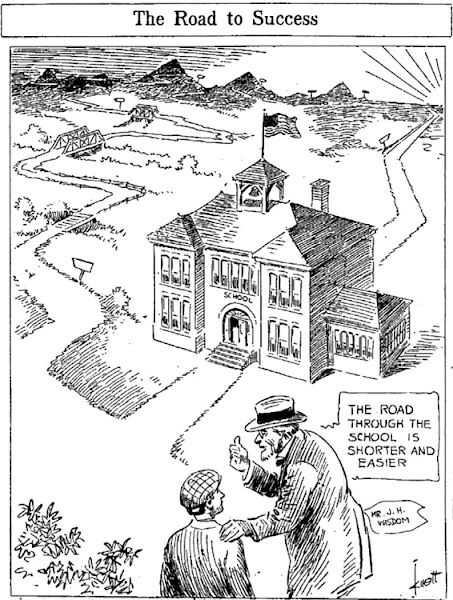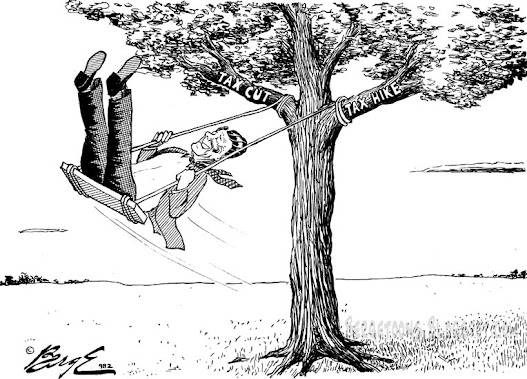I had intended to publish this Graphical History Tour last week, but then Mikhail Gorbachev up and died, so I had to post cartoons about him instead. So here, with apologies to the British royal family for not coming up with a collection of QEII toons, is my 1922 Back to School tribute.
 |
"Freckles and His Friends" by Merrill Blosser for NEA, Sept. 5, 1922
|
Freckles must have been utterly oblivious to the passage of time that summer if he somehow was completely unaware of the start of the school year. I could see him forgetting about it if he were just entering kindergarten, but he's obviously a year or two into schoolboydom if he views going to school as "Just Like Going to Jail."
From the look of things, he's getting the school year off on the wrong foot. The school bell is ringing, and he's at least a quarter mile away. Pop's was not a generation whose cars lined up for blocks dropping off and picking up their younguns at school.
 |
| "Life's Little Tragedies" by Alfred "Zere" Ablitzer in New York Evening Post, Sept. 9, 1922 |
Yeah, kid, go ahead and blame it on the dog.
 |
| "'Cap' Stubs" by Edwina Dumm for George Matthew Adams Service, Sept. 5, 1922 |
Mutts have feelings, too, you know.
 |
"Aw―Gee Whiz" by Gaar Williams in Chicago Tribune, August 27, 1922
|
With the end of summer, the rest of these schoolboys, unlike Freckles McGoosey, were well aware of their impending doom. The lad in Gaar Williams's cartoon may try to hide, but he won't be able to hold his breath underwater long enough to do much but make his own self late for the bell.
 |
"The Hardest Part" by Elmer Bushnell for Central Press Association, ca. August 30, 1922
|
As you have probably noticed, these cartoons are all about boys. Girls went to school, too, but they apparently didn't grow up to draw cartoons about it.
 |
| "'Cap' Stubs" by Edwina Dumm for George Matthew Adams Service, Aug. 28, 1922 |
Even in Edwina Dunn's strip, the girls are peripheral characters — like Violet and Patty, or Susie Derkins, or Katie Franklin. (As we discussed last March, Cap, too, would also be relegated to the margins as Tippie the Dog took over the strip.)
 |
"Another Strike Possibility" by Terry Gilkison for Autocaster, ca. August 18, 1922
|
Reluctant schoolboys are already a cliché in 1922, so let's turn to a cartoon that made an extra effort to be timely. Terry Gilkison references here the months-long and contentious strikes by coal miners and railway workers in his back-to-school cartoon.
By the time my generation was matriculating, teacher strikes were no longer the stuff of a kid's fanciful imagination. For a while, teachers in my school district were going on strike just about every other year. A strike during my senior year lasted nearly two months; when it was over, the district had to add several Saturdays and the entire month of June to the school year in order to meet the state-mandated minimum number of school days. (We seniors got to graduate on schedule so that those of us going to college could meet their deadlines for sending in our graduation records. Everyone else had to go to school for three more weeks.)
 |
"The Days of Real Sport" by Clare Briggs in New York Tribune, August 17, 1922
|
School has not been the only option for older kids, then or now, as illustrated by this Clare Briggs cartoon. For some people, an early entry into the workforce is the right answer. Ma and Pa do not believe that Malcolm here is one of those people, and are old enough to remember a time when many kids Malcolm's age had been in the workforce for years.
(Malcolm, for that matter, is old enough to remember those days, too; even if he didn't personally know anyone in that situation.)
 |
"The Road to Success" by John Knott in Galveston Daily News, September 12, 1922
|
John Knott's Mr. J.H. Wisdom would give Malcolm the same advice as his parents.
And not just to boys like Freckles, Cap, and Malcolm:
 |
| "School Authorities Report..." by John Knott in Galveston Daily News, Sept. 25, 1922 |
Now, I'm putting together something for next Saturday already, so nobody important gets to die next week, okay?






.jpg)











































